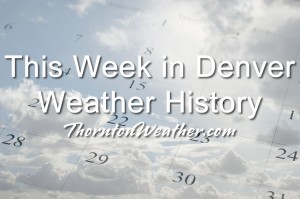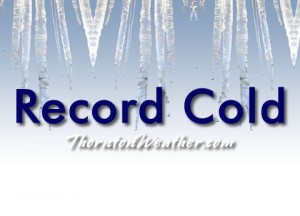
Our look back at this week in Denver includes a stunning array of extraordinary weather. Typical springtime severe weather with hail, damaging wind, tornadoes and deadly lightning are very prevalent. Snow has even made an appearance on more than one occasion.
From the National Weather Service:
20-27
In 2002…lightning sparked a wildfire near Deckers. Extremely dry conditions and very strong winds the following day allowed the fire…known as the Schoonover…to consume 3850 acres before it could be contained. Thirteen structures were destroyed…including 4 homes…resulting in 2.2 million dollars in damage.
24-26
In 1996…a late spring snowstorm dumped 4 to 10 inches of snow over the Front Range foothills. Conifer picked up 10 inches of new snow; Aspen Springs…9 inches; and Central City…8 inches. The sticky…heavy snow clung to power lines and pulled tree branches down…causing power outages to about 1200 homes in the Conifer area. It took up to 6 hours to restore power to some residences. Lightning struck a telephone data cabinet in Conifer on the 25th…which knocked out phone service to about 1500 customers. Widespread rain fell across metro Denver… Where rainfall totaled 2.07 inches at the site of the former Stapleton International Airport and 1.66 inches at Denver International Airport where north winds gusted to 24 mph on the 26th.
In 2010…high winds preceding a cold front…swept across the Front Range foothills and urban corridor. In Aurora… The wind damaged the roof of Rangeview High School. In Conifer and Denver…the wind downed trees and power lines and caused several brief outages. The downed power lines also caused several cars to catch fire in the vicinity of 1590 Cook St. in Denver. Peak wind gusts included: 82 mph at Highlands Ranch…67 mph…4 miles east of Franktown and Longmont; 65 mph in Boulder…64 mph in Centennial and Denver International Airport…62 mph near Parker and 60 mph in Arvada.
25-26
In 1950…a major storm dumped 10.0 inches of snowfall downtown and 10.7 inches at Stapleton Airport where northwest winds gusted to 30 mph on the 25th. The storm caused extensive damage to utility wires and trees which were in full leaf. A daily record minimum temperature of 31 degrees occurred on the 25th. This was the coldest temperature on this date in 79 years and for so late in the season.
In 1989…a late season snow storm dropped snow as low as 6 thousand feet along the Front Range. Most places in the foothills had 2 to 5 inches of snow. Overnight rainfall totaled 0.33 inch at Stapleton International Airport where north winds gusted to 37 mph on the 25th.
In 1994…lightning struck a television transmitter on Lookout Mountain near Golden and burned out a switcher…which disrupted cable service for 2 hours.
26
In 1897…apparent post-frontal north winds were sustained to 42 mph with gusts as high as 48 mph.
In 1942…the all-time highest recorded temperature in May…95 degrees…occurred.
In 1978…two children were struck and killed by lightning on a junior high school playground in Parker.
In 1987…1 inch diameter hail fell near Boulder and Bennett. The hail was fairly soft and caused no damage.
In 1993…dry thunderstorms produced wind gusts to 81 mph at Jefferson County Airport near Broomfield. Several trees were blown down by the strong winds. Microburst winds gusted to 51 mph at Stapleton International Airport.
In 1995…a woman was injured in Littleton when the car she had just entered was struck by lightning. All of the windows in the car were blown out by the strike. A funnel cloud was sighted near Littleton.
In 2000…a strong microburst wind gust to 92 mph flipped a small airplane on its back and blew a dc-3 loose from its moorings…which allowed it to roll onto a grassy field at Front Range airport near Watkins.
In 2010…severe thunderstorms pounded parts of the urban corridor with very large hail…heavy rain…damaging winds and a tornado. The hail…ranging in size from 1 inch to 2 3/4 inches in diameter…struck Brighton…Commerce City and northeast Denver the hardest. The storms continued to spread destruction to the north and east…impacting byers…Hudson…Deer Trail and Prospect Valley. The combination of hail and wind stripped the bark and branches from trees. Numerous accidents were reported as the hail accumulated up to a foot deep. Snowplows were called out to clear the roadways. Flash flooding occurred along State Highway 52 between Hudson and Keenesburg…and forcing the closure of the highway. Widespread crop damage was also reported as the area was inundated with up to 18 inches of water. Extensive damage to homes…businesses and automobiles was reported with the damage estimated to be around 70 million dollars. A tornado touched down near Denver International Airport…but did no damage. Lightning struck a child in Commerce City while she was watching television. She suffered minor injuries to her leg. At the Rocky Mountain Arsenal Wildlife Refuge…a lightning strike killed a bison. At Denver International Airport…only 0.01 inch of rainfall was observed…along with a peak wind gust to 48 mph from the southeast.
Continue reading May 26 to June 1: This Week in Denver Weather History


